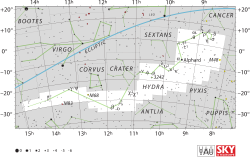9 Hydrae
| 9 Hydrae | |
 | |
| Observationsdata Epok: J2000.0 | |
|---|---|
| Stjärnbild | Vattenormen |
| Rektascension | 08t 41m 43,33591s[1] |
| Deklination | -15° 56′ 36,1727″[1] |
| Skenbar magnitud () | +4,866[2] |
| Stjärntyp | |
| Spektraltyp | K0 III CNII[3] |
| U–B | +0,92[4] |
| B–V | +1,07[4] |
| Astrometri | |
| Radialhastighet () | -1,98 ± 0,12[1] km/s |
| Egenrörelse (µ) | RA: 3,676[1] mas/år Dek.: -97,743[1] mas/år |
| Parallax () | 15,9089 ± 0,1297[1] |
| Avstånd | 205 ± 2 lå (62,9 ± 0,5 pc) |
| Absolut magnitud () | +0,81[5] |
| Detaljer | |
| Massa | 1,72 ± 0,46[6] M☉ |
| Radie | 11,10+0,15-0,69[1] R☉ |
| Luminositet | 54,445+0,536-0,457[1] L☉ |
| Temperatur | 4 688 ± 5[7] K |
| Metallicitet | -0,01[7] dex |
| Vinkelhastighet | 1,7[7] km/s |
| Andra beteckningar | |
| AKARI-IRC-V1, J0841433-155636, BD-15 2554, CCDM J08417-1557A, FK5 2684, GSC 06012-01921, HD 74137, HIC 42662, HIP 42662, HR 3441, IRAS 08394-1545, IRC -20174, 2MASS J08414334-1556360, PLX 2077, PPM 220495, SAO 154552, TD1 12918, TYC 6012-1921-1, WDS J08417-1557A, Gaia DR2 5710178952977568000, Gaia DR1 5710178948681464192 [8] | |
9 Hydrae, som är stjärnans Flamsteed-beteckning, är en ensam stjärna[9] belägen i den sydvästra delen av stjärnbilden Vattenormen. Den har en skenbar magnitud på 4,87[2] och är synlig för blotta ögat där ljusföroreningar ej förekommer. Baserat på parallaxmätning inom Hipparcosuppdraget på ca 15,9[1] mas, beräknas den befinna sig på ett avstånd på ca 205 ljusår (ca 63parsek) från solen. Den rör sig närmare solen med en heliocentrisk radialhastighet på ca –2 km/s.[4]
Egenskaper
[redigera | redigera wikitext]9 Hydrae är en orange till gul jättestjärna av spektralklass K0 III CNII,[3] där suffixnoten anger ett överskott av dicyan i spektrumet. Den ingår i röda klumpen,[10] vilket betyder att den befinner sig på den horisontella jättegrenen och genererar energi genom termonukleär fusion av helium i dess kärna. Den har en massa som är ca 1,7[6] solmassor, en radie som är ca 11[1] solradier och utsänder från dess fotosfär ca 54[1] gånger mera energi än solen vid en effektiv temperatur av ca 4 700[7] K.
Referenser
[redigera | redigera wikitext]- Den här artikeln är helt eller delvis baserad på material från engelskspråkiga Wikipedia, 9 Hyrae, 27 december 2019.
Noter
[redigera | redigera wikitext]- ^ [a b c d e f g h i j k] Brown, A. G. A.; et al. (Gaia collaboration) (August 2018). "Gaia Data Release 2: Summary of the contents and survey properties". Astronomy & Astrophysics. 616. A1. arXiv:1804.09365. Bibcode:2018A&A...616A...1G. doi:10.1051/0004-6361/201833051. Gaia DR2 record for this source at VizieR.
- ^ [a b] Høg, E.; et al. (2000). "The Tycho-2 catalogue of the 2.5 million brightest stars". Astronomy and Astrophysics. 355: L27–L30. Bibcode:2000A&A...355L..27H.
- ^ [a b] Houk, N.; Smith-Moore, M. (1988). "Michigan Catalogue of Two-dimensional Spectral Types for the HD Stars. Volume 4, Declinations -26°.0 to -12°.0". Michigan Catalogue of Two-dimensional Spectral Types for the HD Stars. 4. Bibcode:1988mcts.book.....H.
- ^ [a b c] Johnson, H. L. (1966). "UBVRIJKL Photometry of the Bright Stars". Communications of the Lunar and Planetary Laboratory. 4: 99. Bibcode:1966CoLPL...4...99J.
- ^ Anderson, E.; Francis, Ch. (2012), "XHIP: An extended hipparcos compilation", Astronomy Letters, 38 (5): 331, arXiv:1108.4971, Bibcode:2012AstL...38..331A, doi:10.1134/S1063773712050015.
- ^ [a b] Allende Prieto, C.; Lambert, D. L. (1999). "Fundamental parameters of nearby stars from the comparison with evolutionary calculations: masses, radii and effective temperatures". Astronomy and Astrophysics. 352: 555–562. arXiv:astro-ph/9911002. Bibcode:1999A&A...352..555A.
- ^ [a b c d] Massarotti, Alessandro; Latham, David W.; Stefanik, Robert P.; Fogel, Jeffrey (2008). "Rotational and Radial Velocities for a Sample of 761 Hipparcos Giants and the Role of Binarity". The Astronomical Journal. 135: 209. Bibcode:2008AJ....135..209M. doi:10.1088/0004-6256/135/1/209.
- ^ "9 Hya". SIMBAD. Centre de données astronomiques de Strasbourg. Hämtad 26 april 2019.
- ^ Eggleton, P. P.; Tokovinin, A. A. (September 2008), "A catalogue of multiplicity among bright stellar systems", Monthly Notices of the Royal Astronomical Society, 389 (2): 869–879, arXiv:0806.2878, Bibcode:2008MNRAS.389..869E, doi:10.1111/j.1365-2966.2008.13596.x.
- ^ Alves, David R. (August 2000), "K-Band Calibration of the Red Clump Luminosity", The Astrophysical Journal, 539 (2): 732–741, arXiv:astro-ph/0003329, Bibcode:2000ApJ...539..732A, doi:10.1086/309278.





